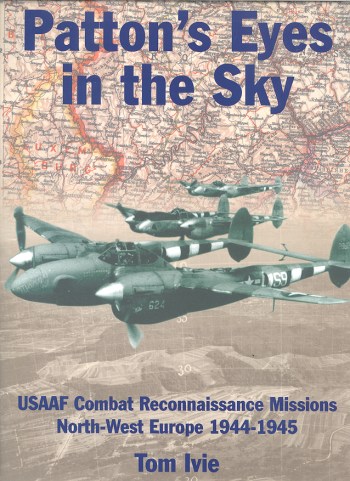 When
this book arrived, I thought, now here is something about which I've read
very little. For some reason, recce units just don't seem to have gotten
the press that the more exiting fighter or even bomber units received.
When
this book arrived, I thought, now here is something about which I've read
very little. For some reason, recce units just don't seem to have gotten
the press that the more exiting fighter or even bomber units received.|
Title: |
Patton's Eyes in the Sky: USAAF Combat Recce in NW Europe: 1944/45 |
|
Author: |
Tom Ivie |
|
Publisher |
Classic Publications |
|
Price |
$44.95 from Specialty Press |
|
Reviewer: |
|
| Notes: | ISBN: 1-903223-26-1 |
 When
this book arrived, I thought, now here is something about which I've read
very little. For some reason, recce units just don't seem to have gotten
the press that the more exiting fighter or even bomber units received.
When
this book arrived, I thought, now here is something about which I've read
very little. For some reason, recce units just don't seem to have gotten
the press that the more exiting fighter or even bomber units received.
Tom Ivie's book has what one comes to expect from a Classic Publications effort. It is well thought out with superb photos and a goodly number of profiles. It is basically the history of the 10th Photo Recon Group, the unit that was responsible for photo and tac recon for Patton's Third Army after D-day.
The book opens with a brief history of US reconnaissance efforts prior to WWII and the build up of units once the war got underway. As with all of America's recce units, they started with P-39s and P-40s, exercising their skills and developing new ones in the US prior to heading overseas. Arriving in the UK just before D-Day, the 10th PRG was tasked with photographing the landing beaches, which often meant very low level and high speed 'dicing' missions over the beachhead to check on German preparations. Once in Europe, the unit was responsible for constantly keeping track of German troop movements and concentrations as well as for determining any road and rail movement behind the front lines.
To accomplish these missions, the 10th PRG operated three basic aircraft types. First was the F-3, which was basically an A-20J equipped for night photography. These aircraft seemed to have had the worst of it in terms of losses, falling to night fighters and flak from both sides in the conflict! The F-4s and F-5s were P-38 Lightnings and these were used for longer ranged daylight photo recon. The F-6s were P-51 Mustang variants that were used for tactical reconnaissance. Tac recon was as much visual as photographic and often the Mustangs lead fighter-bomber units directly to targets that they had discovered. The Mustang was also armed, unlike the Lightning, so there were a few aces amongst the F-6 squadrons.
As with any air group, squadrons were fluid with some units drawn from other groups and some being farmed out as the needs of the war dictated. It is interesting to this reader that many of the squadrons in the 10th PRG lasted until the early 1990s when the 67th TRW, then flying RF-4C Phantoms (the last specially built American Tacticaly Recce planes) disbanded.
The book is an exciting read into the little-known world of combat reconnaissance and is geared as much to the modeler in its profiles and interesting info as it is to the historian. Just as an interesting modeling note, there is a photo of an F-6A with the insignia painted on upside down, so it isn't just modelers that make errors!
Highly recommended
Review book courtesy of
![]() ,
where you can order your copy of this and many other superb aviation and
modeling books.
,
where you can order your copy of this and many other superb aviation and
modeling books.
If you would like your product reviewed fairly and quickly by a site that has well over 200,000 visitors a month, please contact me or see other details in the Note to Contributors.